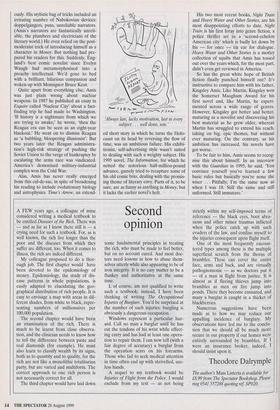Second opinion
A FEW years ago, a colleague of mine considered writing a medical textbook to be entitled Diseases of the Rich. There was — and as far as I know there still is — a crying need for such a textbook. For, as is well known, the rich live longer than the poor and the diseases from which they suffer are different, too. When it comes to illness, the rich are indeed different.
My colleague proposed to do a thor- ough job. The first chapter would have been devoted to the epidemiology of money. Epidemiology, the study of dis- ease patterns in whole populations, is easily adapted to elucidating the geo- graphical distribution of rich people. It is easy to envisage a map with areas in dif- ferent shades, from white to black, repre- senting numbers of millionaires per 100,000 population.
The second chapter would have been an examination of the rich. There is much to be learnt from close observa- tion, and the clinician needs to know how to tell the difference between paste and real diamonds (for example). He must also learn to classify wealth by its signs, both as to quantity and to quality, for the rich are not like a monolithic totalitarian party, but are varied and multiform. The correct approach to one rich person is not necessarily correct for all.
The third chapter would have laid down some fundamental principles in treating the rich, who must be made to feel better, but on no account cured. And most doc- tors need lessons in how to abase them- selves utterly while also appearing to be of iron integrity. It is no easy matter to be a flunkey and authoritative at the same time.
I, of course, am not qualified to write such a textbook; instead, I have been thinking of writing The Occupational Injuries of Burglars. You'd be surprised at the number of such injuries: burgling is obviously a dangerous occupation.
Windows represent a particular haz- ard. Call no man a burglar until he has cut the tendons of his wrist while effect- ing entry and has had at least one opera- tion to repair them. I can now tell (with a fair degree of accuracy) a burglar from the operation scars on his forearms. Those who fail to seek medical attention in time often end up with shrivelled, use- less hands.
A sequel to my textbook would be Injuries of Flight from the Police. I would exclude from my text — as not being strictly within my self-imposed terms of reference — the black eyes, boot abra- sions and other minor traumas inflicted when the police catch up with such evaders of the law, and confine myself to the injuries consequent upon flight itself.
One of the most frequently encoun- tered types among these is the multiple superficial scratch from the thorns of brambles. These can cover the entire face, arms and back, and are virtually pathognomonic — as we doctors put it — of a man in flight from justice. It is almost as if fleeing thieves jump into brambles as men on fire jump into ponds. There they become ensnared, and many a burglar is caught in a thicket of blackberries.
Numerous suggestions have been made as to how we may reduce our appalling incidence of burglary. My observations have led me to the conclu- sion that we should all be much more secure in our property if our homes were entirely surrounded by brambles. If I were an insurance broker, indeed, I should insist upon it.
Theodore Dalrymple
The author's Mass Listeria is available for £8.99 from The Spectator Bookshop. Please ring 0541 557288 quoting ref. SP020.


























































 Previous page
Previous page